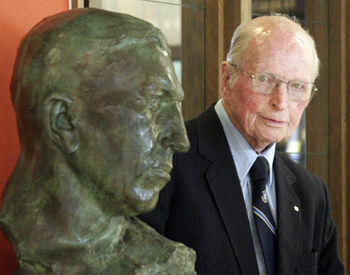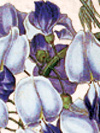| History of the Memorial Room Collection Page 4 |
|
||||||||||||||||||
 |
Expanded remarks by Professor Emeritus, Wm. C. Gibson, D.Phil.(Oxon) M.D., F.R.C.P., September 7, 1988 at the dedication of the Historical Collection of the Woodward Library, University of British Columbia. The Life Sciences Libraries thanks Dr. William Gibson for his kind permission to reproduce his historical comments on the Historical Collection of the Woodward Library. |
|||||||||||||||||
Baz was implicated in another windfall. The occasion was a strike of employees in airlines in the United States. A book dealer from Boston had the fallacious notion that he could circumvent the problem by flying across Canada and slipping down the west coast to the University of California with some rare materials for sale. He arrived in Vancouver late in the evening to find that there was no way of proceeding to the United States, and moreover, every hotel in Vancouver was jammed with travellers awaiting passage to American destinations. The only person the bookman had ever heard of in Vancouver was Basil Stuart-Stubbs; so just short of midnight he telephoned Baz asking if he knew where he could find a room. Baz assured him that there was a room at the Faculty Club, and advised him to take a taxi to the campus at once. In helping the poor fellow by carrying his bags into the club Baz remarked on the weight of two large suitcases, "Oh," said the Bostonian, "They are filled with Florence Nightingale letters I hope to sell in California." In a flash Baz was on the telephone to my house down Marine Drive from the campus, pleading, "Have you got any Scotch in the house?" I admitted that there just happened to be, and in a trice, the pair were trundling two large suitcases into the living room, where my wife had lit the fire. Suffice it to say that by 3 a.m. we had acquired all the contents of the suitcases, which we kept in our house overnight, and sent Baz's newly acquired but exuberant friend off to bed at the Faculty Club. We told him not to bother, in the future, going to California but to bring his wares directly to U.B.C. After a fitful sleep my wife was up early, sitting on the floor reading these priceless letters. She was mystified over twelve letters, in a different hand, and tied with a ribbon in a separate package. After months of research she was able to show that these had been written from the Crimea, not by Florence Nightingale, but by a Canadian nurse, born in Kingston, Ontario, where her father, Admiral Barrie, presided over the British forces charged with keeping the American troops at bay, following the war of 1812-1814. His daughter joined the Bermondsey nuns in London as Sister Mary Gonzaga. After her service with them in Crimea she returned to London where she founded the Hospital of St. John and Ste. Elizabeth. Some of the notes in another special package turned out to be part of the original text of a book written by another nurse returning to Britain from Scutari. This solved a mystery with which Dr. Noel Poynter at the Wellcome Library in London had been occupied for years. He used to chide his friends there by saying, "If you want a mystery solved ask Barbara Gibson at the Woodward Library in Vancouver." With the extension of the building it was possible to construct the Sherrington Seminar Room, connected discretely to the beautiful Memorial Room. Sir Charles died in 1952 at the age of ninety-five, in Eastbourne. I had the good fortune to visit him in 1951 en route home from the International Congress on Polio-Myelitis in Copenhagen where Jonas Salk and others were featured. Sir Charles had the gasfire in his room in the Esperance nursing home turned up full, though it was only September. He was very arthritic in body but not in mind. He said, "Now Gibson, how many doctors did you say were at Copenhagen?" "Six hundred, Sir Charles." "Did any good ever come of 600 doctors getting together?" Little did we know that within a year a vaccine against polio would change the world. Sir Charles was still writing poetry, and as always, asked if "dear Frank Wesbrook's memory was still green in Vancouver?" I assured him prematurely it was, for the biography which I was to write Wesbrook and His University, was still only a dream. Sherrington received in his long and distinguished career ninety honorary degrees and fellowships. He had the longest entry in Who's Who, and was one of the 24 scholars and servants of the public to achieve the Order of Merit from the Crown. He had been President of the Royal Society of London and of the British Association for the Advancement of Science. Twice the Prime Ministers of Great Britain had named him a Trustee of the British Museum--second time at age 80. Neither before nor after his death did Oxford, his professional home, make any move to memorialize him, so his son Carr, one of Eisenhower's British advisors, on learning of our Sherrington Room plans, sent out to us all of his father's honorary degrees and fellowship parchments, his portrait painted by Eves for the Royal Society, his Nobel Prize citation, his Order of Merit medal, his Royal Society regalia consisting of a velvet suit, cocked hat and ceremonial sword, and finally his dining room chairs. They had been shunted around Britain during the "blackout" and were in need of refurbishing when they arrived. To each we affixed a small brass plate, giving the names of the colleagues who used to gather, over the years, to enjoy the Sherringtons' hospitality. They represent the cream of the scientists of the century in which he lived. The table around which they are now arranged was found for us by Chancellor Phyllis Ross. It was produced in Ipswich, Suffolk, where Sir Charles was born. (In 1985 Professor Colin Blakemore of the University Laboratory of Physiology at Oxford after much discussion with me and other pupils of C.S.S. decided to go for an addition to his building in order to develop a Sherrington Room worthy of the name. As a result, we shared some of the most colorful diplomas and certificates with them, and there was a grand opening in 1986 to which Sherrington's two extant Nobelist pupils, Eccles and Granit, came, along with Sinclair, Whitteridge, Phillips, and the "lab boys" Giles and Marsland.) Every time we said at the Woodward Library, "That's enough; lets get these treasures properly catalogued", some further treasures would descend upon us. One day a lawyer walked in with a tattered looking object in his hand. He apologized for the state of this Latin volume but had found it in the attic of his recently deceased father, Dr. G.S. Purvis, who had been President of the College of Physicians and Surgeons of B.C. in the 1930's. The donor had no idea what the book was about. He was soon assured that it was a first edition of Agricola's De Re Metallica or The Art of Mining, 1556, published in Basel. This was, as Osler has said "for long the standard work on mining and metallurgy". It was finally translated in 1912 by the future President of the United States, Herbert Hoover with the help of his wife. |
||||||||||||||||
|
||||||||||||||||


